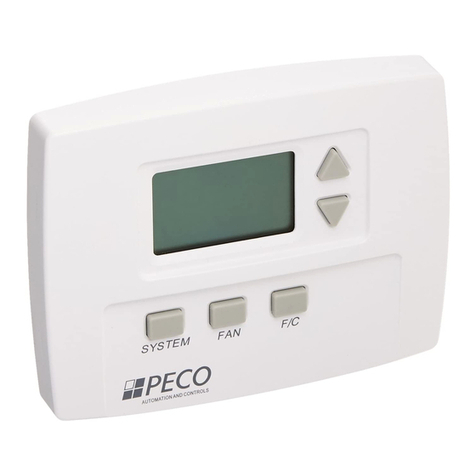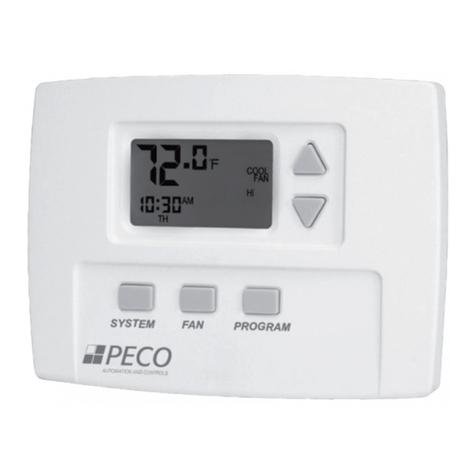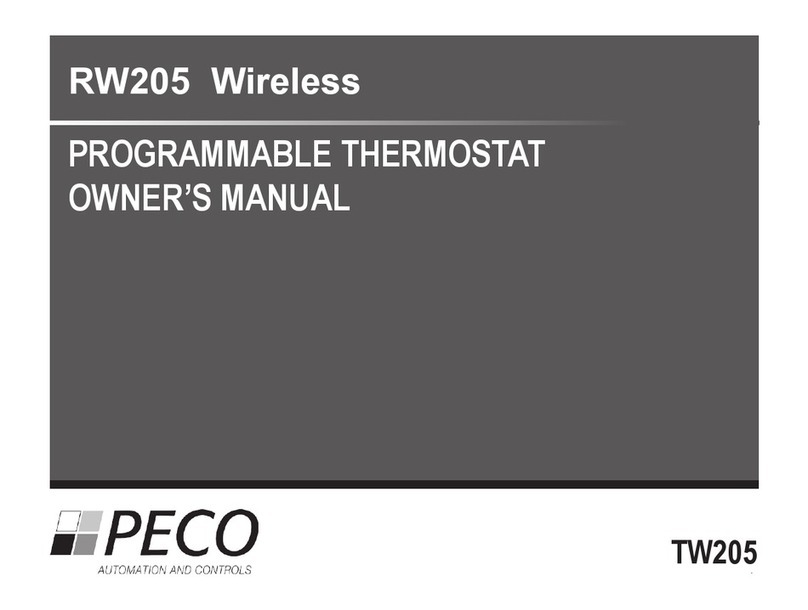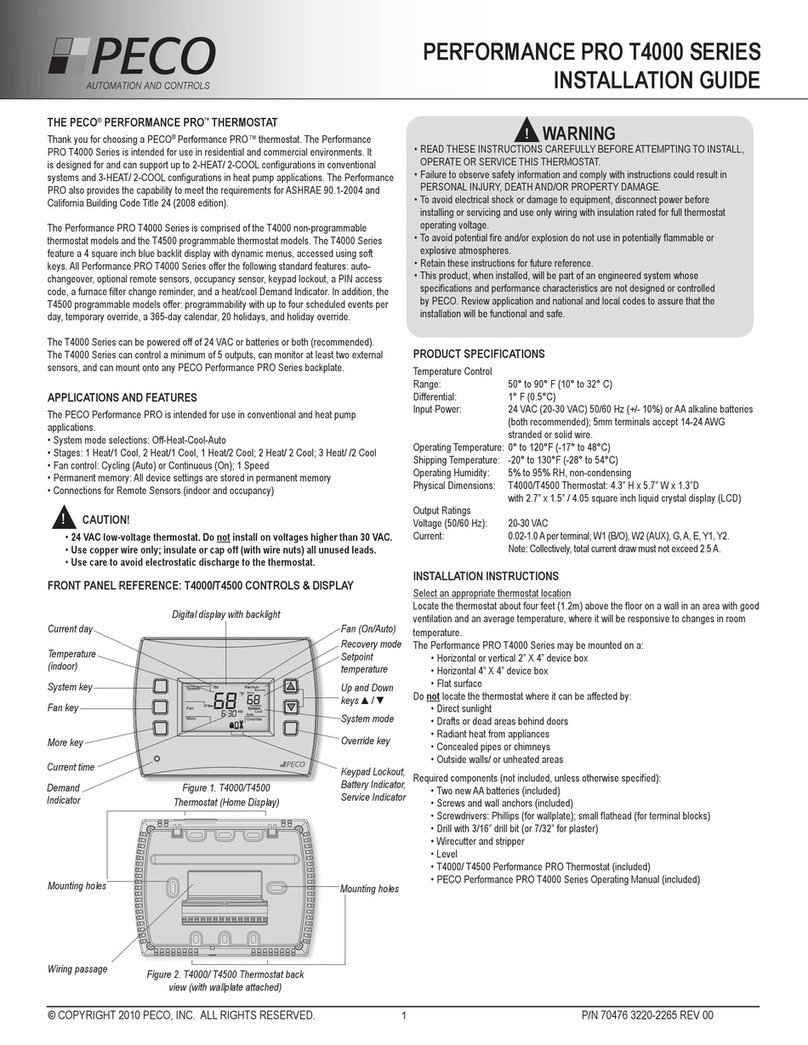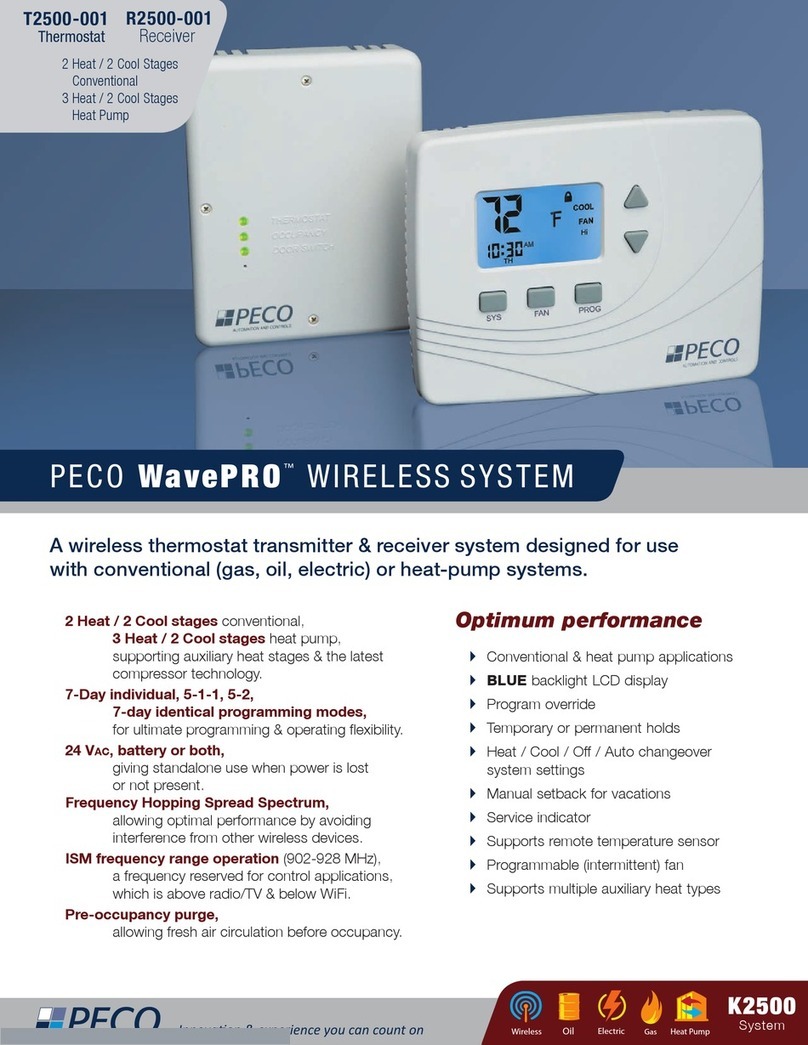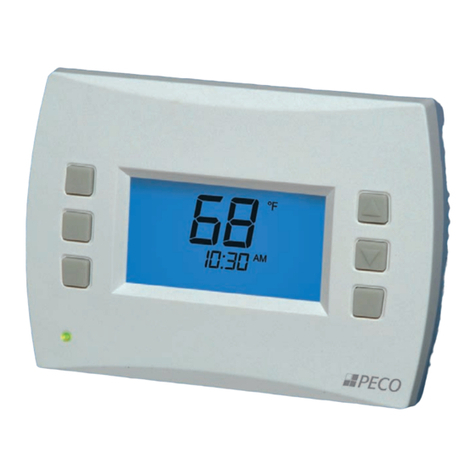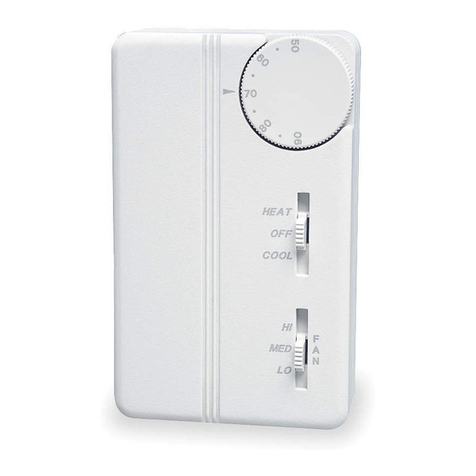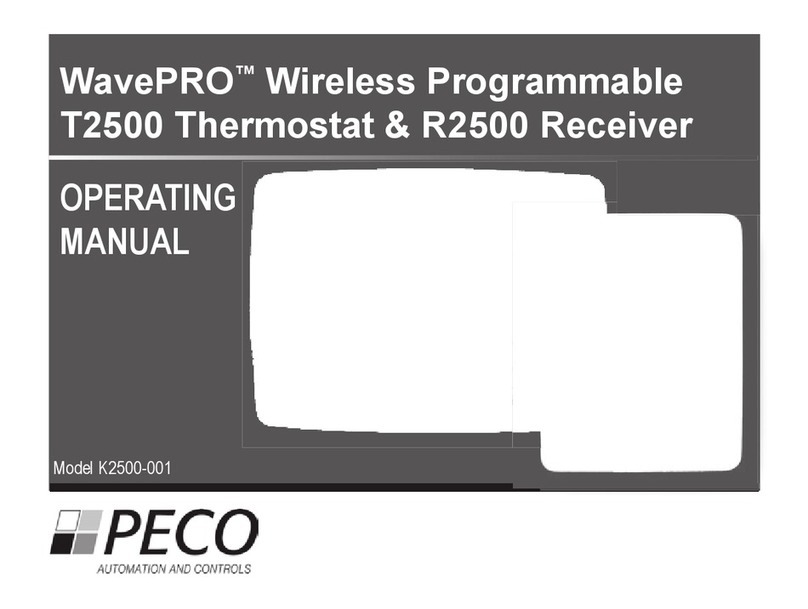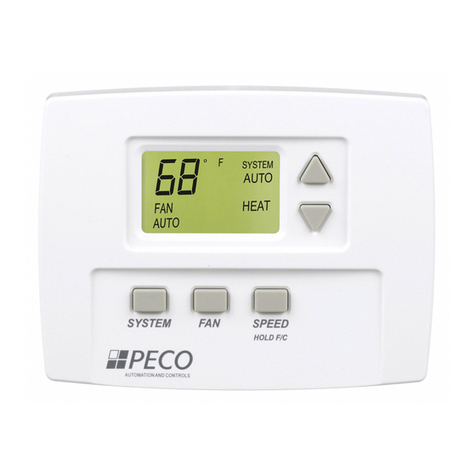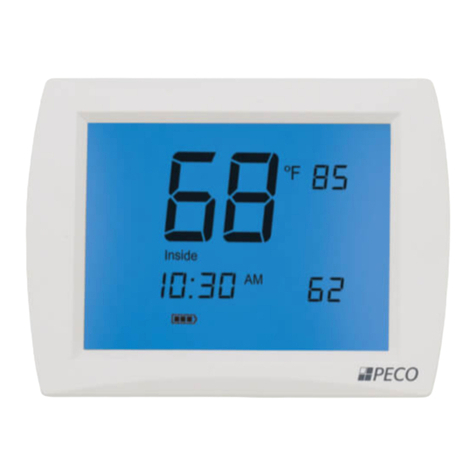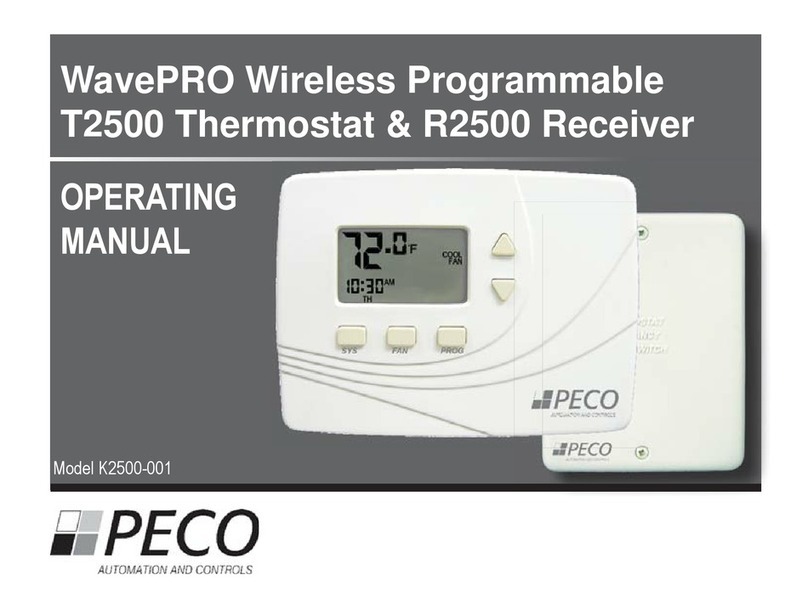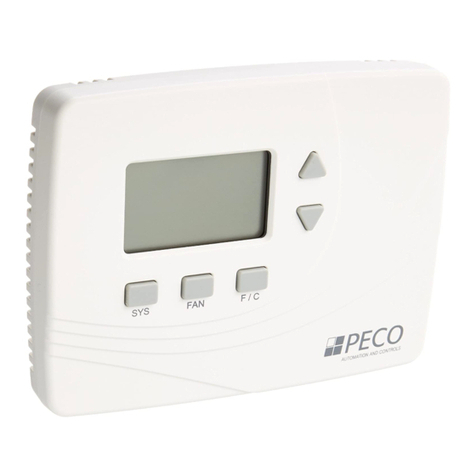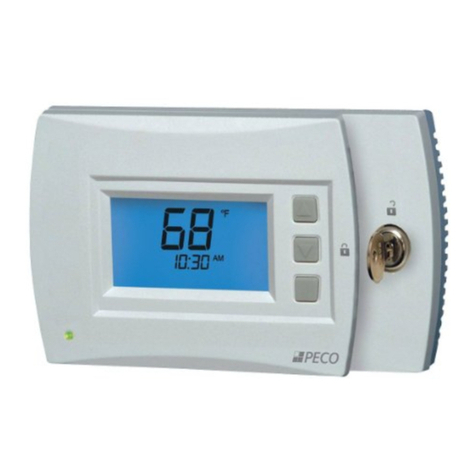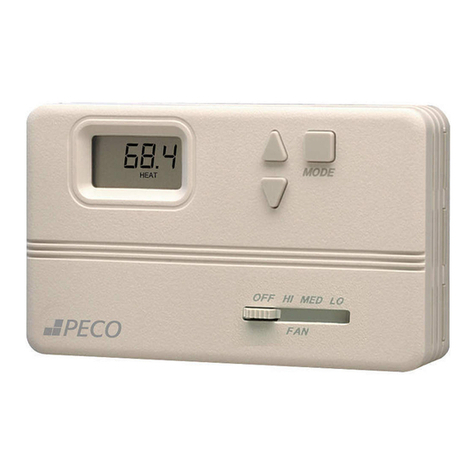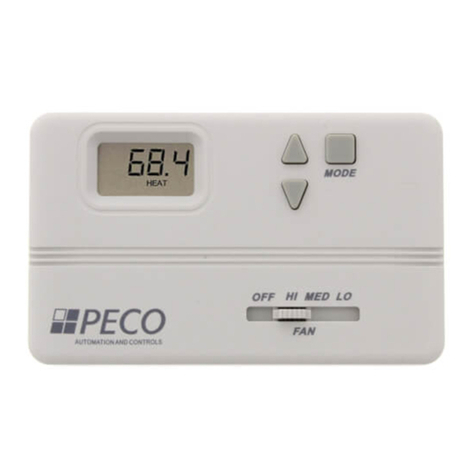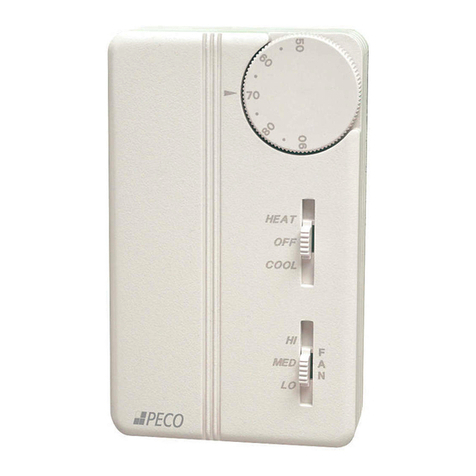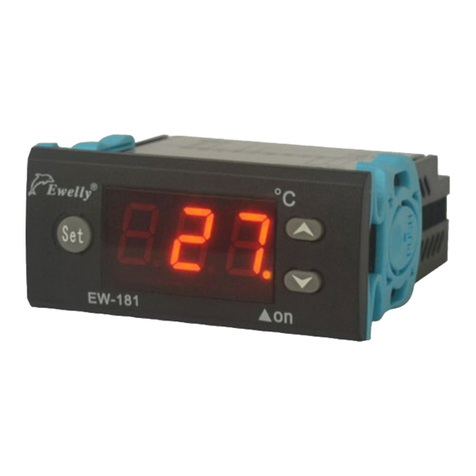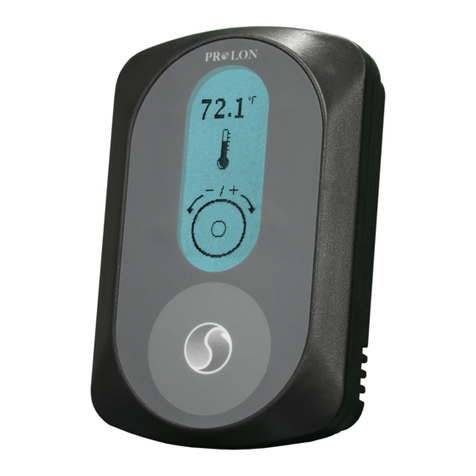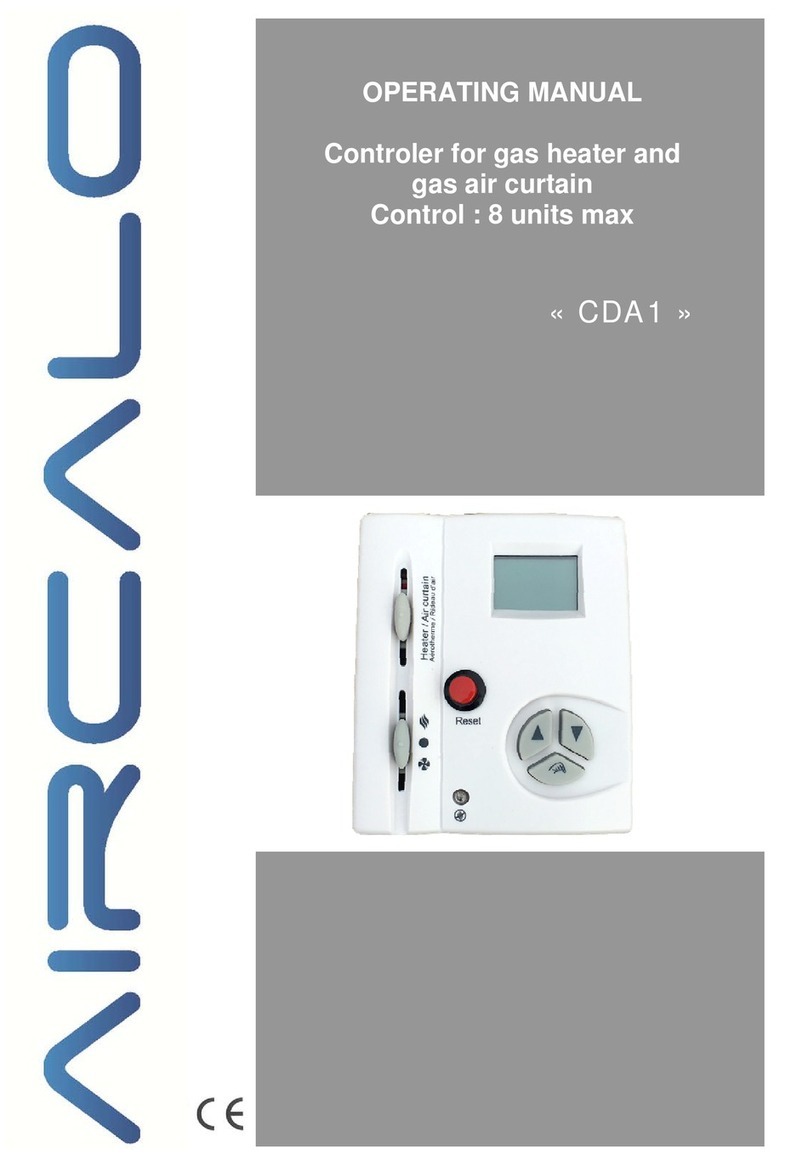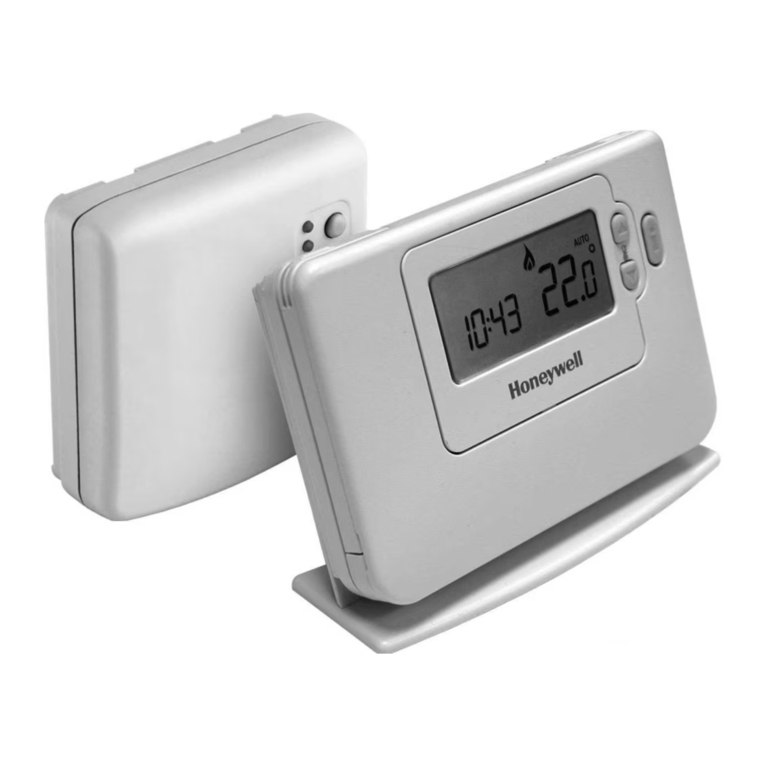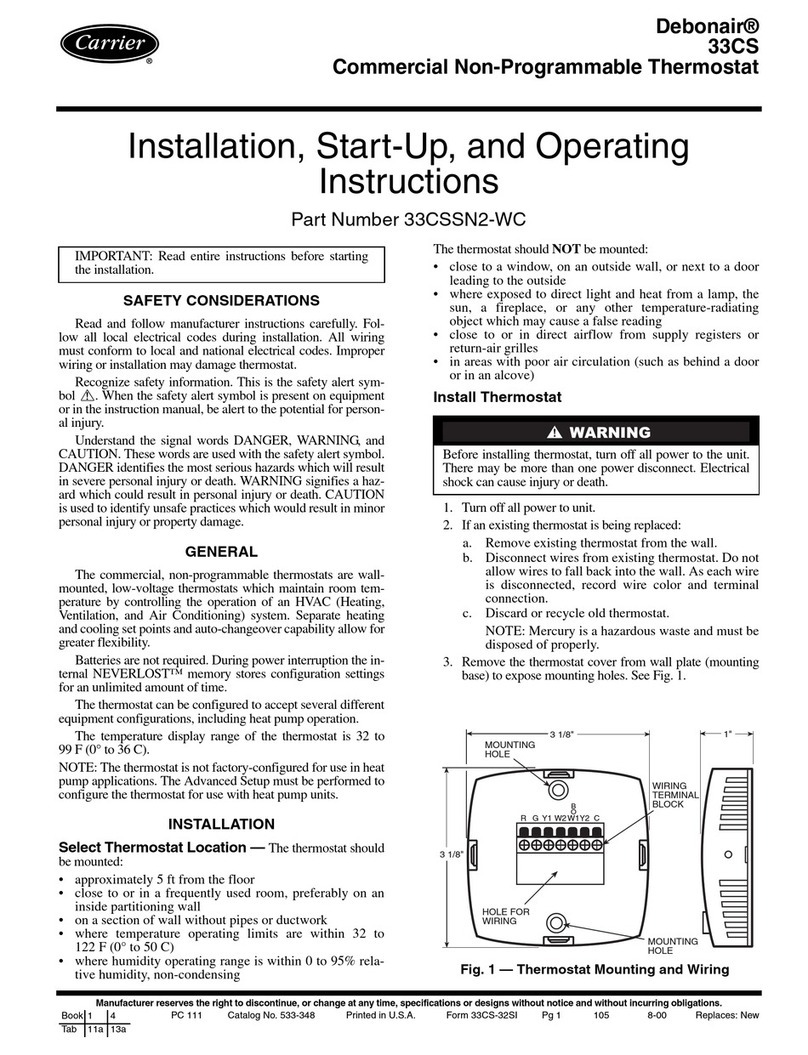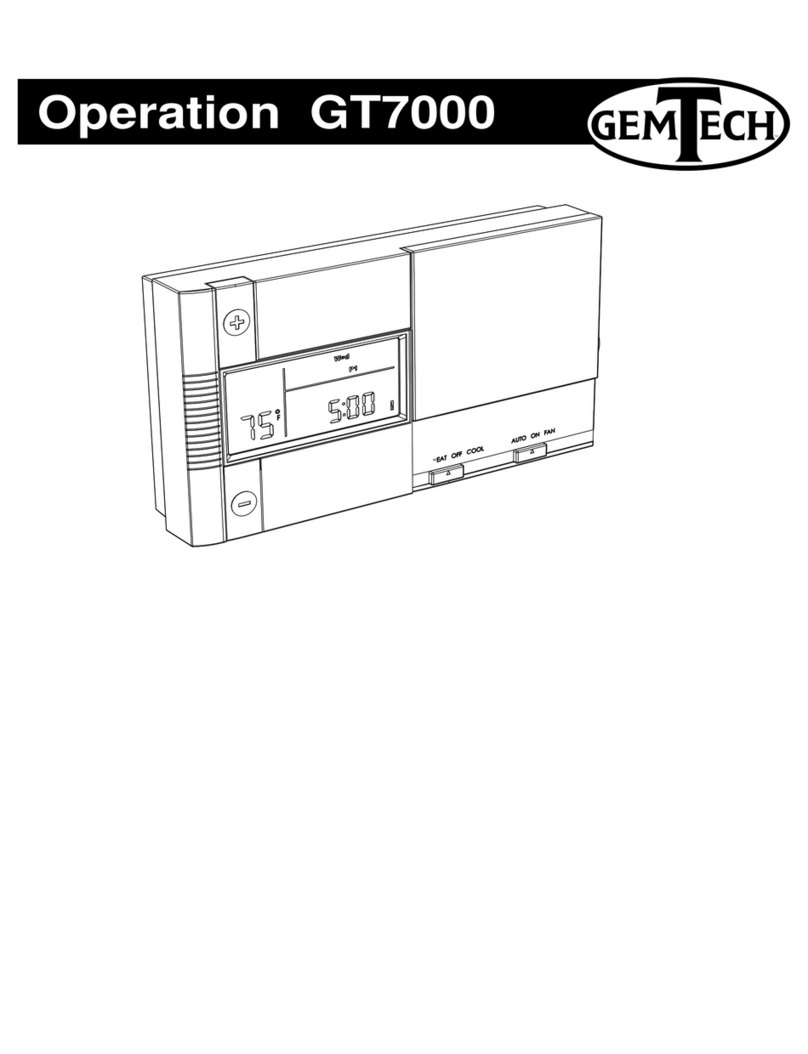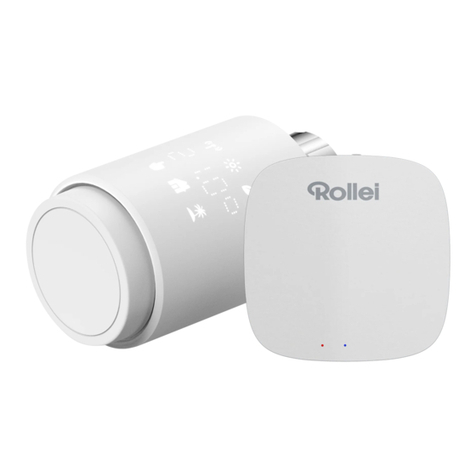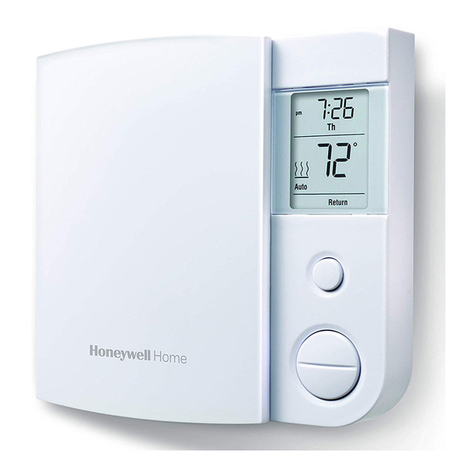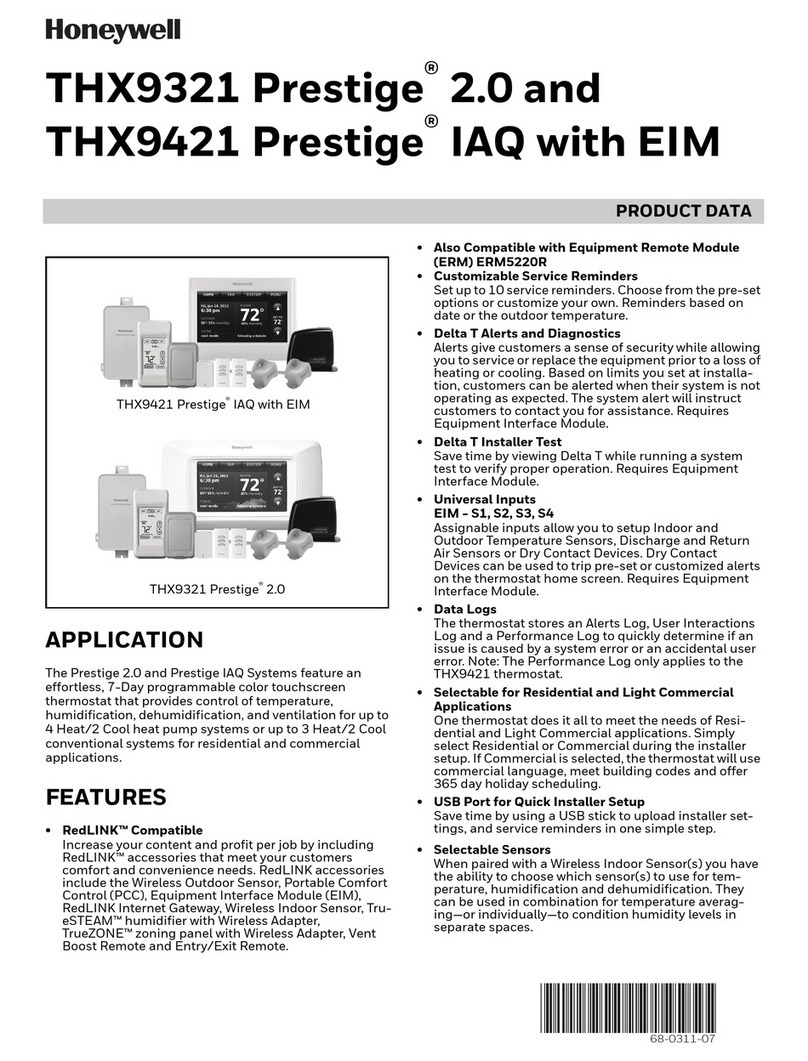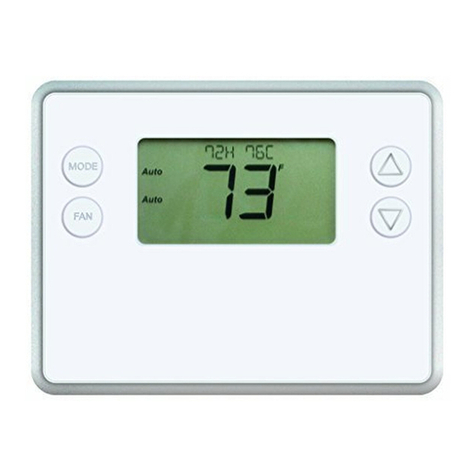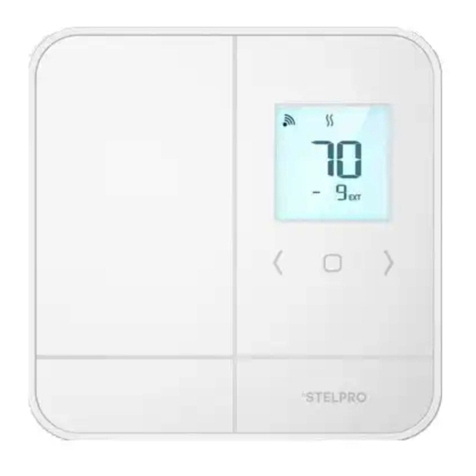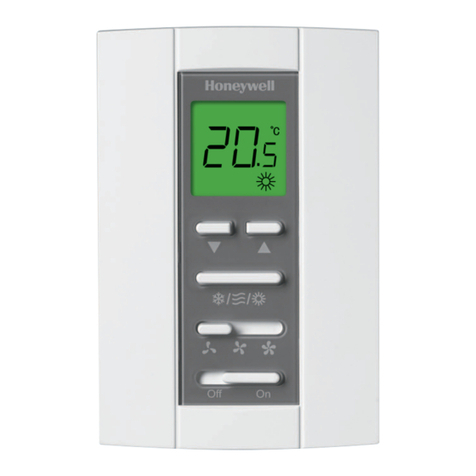
USER OPERATION
Room Temperature and Adjustable Set Point (desired) Temperatures
Unless adjusted in the Service Menu, the thermostat will show the cur-
rent room temperature on the display.
To show the current Set Point Value (desired room temperature), press
either the UP or DOWN arrow keys. The initial power-up Set Point is
72° F. This value can be adjusted using the arrows keys. Adjustments
to the Set Points are stored in the non-volatile memory, and are used for
subsequent power ups.
System Switch Operation (SYS)
OFF: All thermostat outputs are disabled.
HEAT: Operates as a Heating only thermostat.
COOL: Operates as a Cooling only thermostat.
AUTO: The thermostat automatically selects between Heat
ing or Cooling mode depending upon the Set Point
(Desired Temp) and Zone Temperature (Actual
Temp). The appropriate HEAT or COOL icon is
enabled if demand exists.
SETBACK: An energy saving feature that minimizes heating and
cooling when the room is not occupied. The thermo-
stat will control to the SETBACK Heat and Cool Set
Points, rather than the standard Set Points. When in
SETBACK, the display will show the room tempera-
ture along with the SETBACK icon. Key presses will
have no effect on the Setback operation except for
the System Switch Selection button, which allows
the user to exit the SETBACK mode.
AUX HEAT: For emergency heating applications, when the oc-
cupant wants only the Auxiliary Heat Source to oper-
ate. The heat pump does not operate in this mode.
Fan Operation
If the Heat Pump operates with 1 Fan Speed, occupants can choose
either FAN ON or FAN AUTO.
With FAN ON selection, the Fan is on continuously, even when no
heating or cooling is required.
With FAN AUTO selection, the Fan is on only with active demand.
If the Heat Pump operates with 2 Fan Speeds, occupants can choose:
FAN LO, FAN HI, or FAN AUTO.
With FAN LO selection, the fan is on continuously at the fan low
speed.
With FAN HI selection, the fan is on continuously at the fan high
speed.
With FAN AUTO selection, the thermostat selects the fan speed
and enables the appropriate output according to how far the room
is away from the desired Set Point. Fan Low operates between
Set Point and Fan High. Fan High is enabled 2°F from desired
Set Point (congurable via Service Menu 12 Fan Stage Separa-
tion) and is disabled 1°F from the desired Set Point.
Sensor Readings – STATUS Button
Outside Air (OA) Temperature – Push the Status Button to read
value. If a Sensor is connected, the current sensed temperature
will be displayed in the digits along with the OUTSIDE icon. If the
OA input is closed the unit will display F1 in the digits as an indi-
cation that the lter needs to be changed. If this input is open the
unit will skip over OUTSIDE and go directly to the display of %RH.
Relative Humidity (RH) - If a humidity sensor is installed, the %
RH will be displayed by pushing the Status Button. Pressing
the UP or DOWN button will display the current %RH desired
Set Point and will allow the operator to adjust this value. The
SP range for Humidity is 20-45%RH and Dehumidication is 50-
1.
2.
1.
2.
3.
•
•
90%RH.
Selection of Humidify or Dehumidify must be made in Service
Menu 12 to allow the adjustment of %RH Set Point. If Outside Air
operation is selected from Service Menu 12, instead of Humidi-
cation or Dehumidication, then %RH Set Point is only adjustable
for Outside Air selection conguration 4 and 5. If this RH input is
open the unit will skip over %RH and go directly to display of F/C.
Fahrenheit / Celsius- Enables occupant to change readings to
Celsius. Push the status button until F/C option is displayed and
then use the arrow keys to change the display option.
TECHNICAL / APPLICATION NOTES
Dehumidication Control
Dehumidication is only enabled during COOL mode. Selectable range
is 50-90%RH, with a default value of 90%. If you have a TH170-001 (no
onboard RH sensor), the three dehumidication options are disabled in
the service menu.
With most dehumidier equipment, when there is an active RH demand
the output is disabled and in the Normally closed position. If the dehu-
midication equipment operates in the reverse, Service Menu 21 will
allow the installer to enable the output with RH demand.
The dehumidication user selection congurations are:
Dehumidication Only (Default): If the %RH reading > the RH
Set Point (SP) the dehumidier turns on.
Over Cool: The temperature is allowed to drop up to 3°F below
Temp SP to satisfy the dehumidication demand. For every
degree the Temp SP decreases, the %RH SP is automatically
increased by 2%. For every degree the Temp drifts back toward
the Temp SP, the %RH Set Point is automatically decreased by
2%. If the %RH SP is user changed while the %RH SP is being
shifted, the system will use the new %RH SP. During Over Cool
operation, the user selected Temp SP value will only be displayed,
not the Over Cool SP value. The overcool operation used only
Compressor 1, Fan LO, and dehumidication output to meet
dehumanization demand.
Dehumidication OFF: Independent of Dehumidication De-
mand, the output is enabled (dehumidier is off).
Humidication Control
Humidify is only enabled during HEAT or AUX HEAT modes. Selectable
range is 20-45%RH, with a default value of 20%. If you have a TH170-
001 (no onboard RH sensor), all ve Humidication selections are dis-
abled. HU 3-5 are only displayed if an outside air sensor is connected.
The Humidity user selection congurations are:
Humidify Only: Humidity output is enabled (Humidier ON) when
the %RH < RH Set Point.
Humidify with Fan: With a Humidity demand (%RH < RH Set
Point), Humidier and Fan LO are enabled.
Auto Humidify: If the Outside Air Temperature is above 50°F,
the humidity output is enabled (Humidier ON) when the %RH
< RH SP (same as HU1). If the OA Temperature is ≤ 50°F, the
%RH SP is automatically reduced by 1% for every drop of 2°F
in OA Temperature between 0-50°F. The humidication output
is disabled when the RH SP ≤ %RH. The condition is reversed
when the OA Temperature increases between 0-50°F. If the %RH
SP is user changed, the system will use the new SP.
Auto Fan Humidify: In conjunction with conguration 3, Fan LO
is enabled with Humidication demand.
Humidify OFF: Independent of Humidication Demand, the
output is disabled (humidier is OFF)
Outside Air (OA) Economizer Operation
•
•
1.
2.
3.
1.
2.
3.
4.
5.
© COPYRIGHT 2008 PECO, INC. ALL RIGHTS RESERVED. P/N 69290 3220-2088 REV 0 PAGE 4 © COPYRIGHT 2008 PECO, INC. ALL RIGHTS RESERVED. P/N 69290 3220-2088 REV 0 PAGE 5
